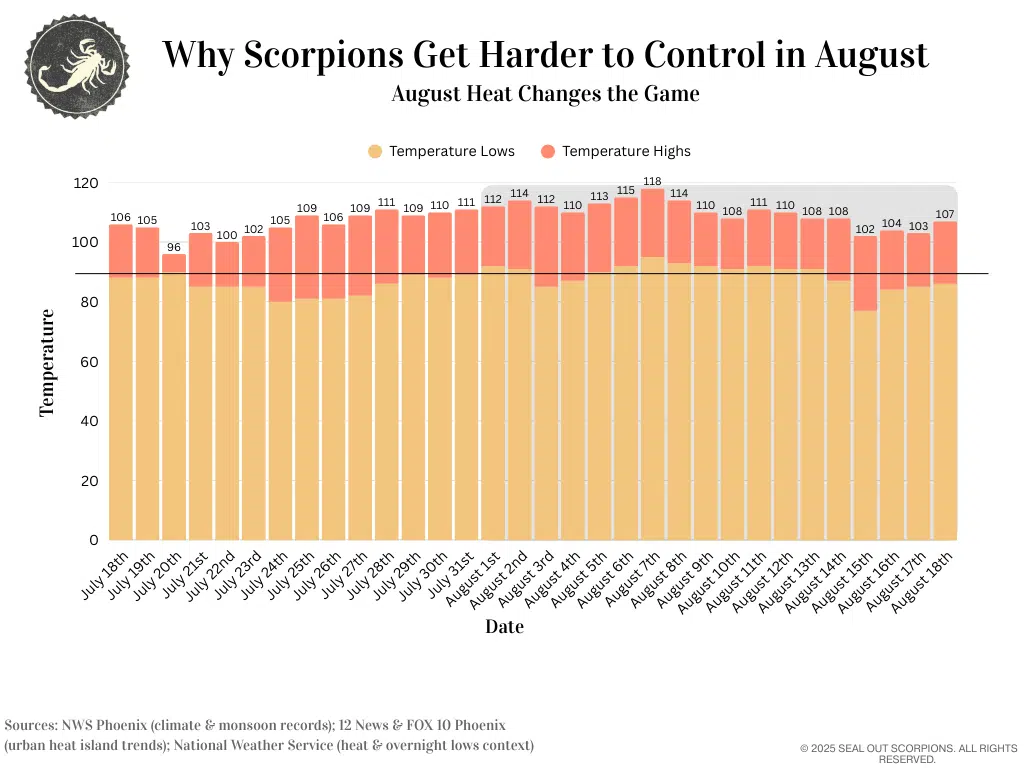Why Scorpions Get Harder To Control In August (And What To Do About It)
August in the Valley is a perfect storm for scorpion problems: extreme heat, wobbly monsoon moisture, high overnight lows, and homeowners relying on spray programs that don’t perform the way they think they do. Below is what’s driving late-summer sting risk and the precise steps that actually help right now.
1) August Heat Changes The Game
Phoenix is running unusually hot in mid-August. The region has piled up 110°F days again this summer, and nights have stayed with abnormally warm conditions. The National Weather Service and local media flagged repeatedly last year and this summer as a growing pattern. Hot nights (lows near or above 90°F) are becoming more common, which means the desert doesn’t cool enough to slow nocturnal arthropods (including bark scorpions).
Why It Matters Biologically:
- High daytime heat + warm nights dehydrate prey insects and scorpions alike. Dehydrated, heat-stressed scorpions push into structures for water and cooler microclimates (slab edges, wall voids, bathrooms, under sinks).
- Urban Heat Island keeps neighborhoods hotter at night than the desert around them, extending activity windows on patios, garages, and in home wall voids.
What This Does To Pesticides:
- Higher temperatures and variable humidity reduce residual performance for many general-use formulations; sublethal exposures alter arthropod behavior, often producing erratic “flush” movement instead of quick knockdown. Peer-reviewed work shows temperature can modulate insecticide impact and sublethal effects, even when label rates are followed (studied on other insects, but the mechanism is instructive for why pesticides stall in peak heat).
Bottom line: August heat creates more stressed scorpions and less reliable chemistry. If all you do is spray, you should expect diminishing returns right now.
2) Monsoon & Moon: Two Signals Homeowners Can Use
Monsoon 2025 has been uneven, with Phoenix notably dry in the 2024 recap (only 0.74″ total last monsoon at Sky Harbor) and an outlook this season that finally leaned “above normal”, but with fits and starts. Translation: brief humid upticks and pop-up storms can spike activity, but long dry stretches push scorpions further indoors.
What to watch for: Forecast discussions in August have highlighted a late-season moisture resurgence, with the potential for renewed storms in central and southern Arizona. This creates brief windows when scorpions roam more widely right after outflows and light rains.
Use The New Moon To Your Advantage
- New Moons reduce ambient skyglow; UV scorpion finds stand out better, and scorpions are typically more exposed during travel when it’s darkest.
- Phoenix new-moon dates 2025: July 24, August 23, September 21 (local calendar). If you’re scheduling a night assessment to understand on-property pressure, target the 3–4 nights around those dates.
Field tip: For homeowner scouting, a high-output UV flashlight such as the UV Beast-class lights (365–395 nm) tends to overpower white light spill, improving contrast on stucco, block walls, eaves, and gravel. (Can be purchased on Amazon for DIY or Seal Out Scorpions offer search and inspection services.)
3) Why August Sightings “Spike” Even When Reports Fall
You may hear that national scorpion exposure reports have eased compared to peaks a decade or two ago. That’s true in aggregate, but it hides a critical local pattern: minor cases decline faster than moderate/major ones, and under-reporting of mild stings is becoming more common. Reports show that moderate and major sting incidents have not declined, just the reports of the total from minor stings. In a hot, dry August, the scorpions that do find their way inside are more distressed , dehydrated or chemically disoriented. Therefore more likely to sting if disturbed. National Poison Data System (NPDS) analyses remain the benchmark for these trends.
Takeaway For Homeowners In August:
Fewer total calls do not lower personal risk. In neighborhoods with active bark scorpions, one sighting is an early-warning signal, not a “one-off.”
4) Why Modern Insecticides Feel Weaker Now
Even the most optimal products are constrained by physics and building air leakage in August:
- Chemistry limits: Extreme heat and aridity shorten residual life and skew behavior toward flush, not kill. This is why you may suddenly see scorpions in kitchens, downstairs living rooms, bedrooms or bathrooms after a service.
- Behavioral reality: Bark scorpions are avid climbers and stilt, often traversing treated surfaces with minimal to no contact time.
- Structural reality: Homes have hundreds of micro air leaks (ceiling fixtures, weep screeds, baseboard gaps, utility penetrations). Sprays don’t close those pathways.
Result: In August, sprays may help suppress symptoms outdoors but don’t change the fact that scorpions can ride out pressure and follow air flow and moisture gradients into the house.
5) What To Do In August (Practical, High-Yield Steps)
A) Schedule a Night Assessment Around The New Moon
- Walk the perimeter, block walls, eaves, and grounds with a strong UV light; Note the count, size class, and harborages.
- Re-check after rain for a truer peak read.
B) Treat August Like “Symptom Suppression” & Prepare For Fall Prevention
- Accept that August is about risk management while you set up structural prevention for September/October. Early intervention prevents winter harborages and pays off during the colder season and into next year with lower spring pressure.
C) Bedroom Protection & “No-Entry” Protocol (high ROI)
- Keep ceiling fans on low overnight; maintain airflow and vibration.
- Pull bed frames 2–3 inches off walls; keep linens from touching the floor.
- Use non-poison glue boards behind nightstands and along baseboards (out of kid/pet reach).
- Do not spray inside; reserve insecticides for contact kill only of visual targets to avoid flushing scorpions to less desirable areas.
D) Fix What Sprays Can’t: Building Performance Sealing Of Micro Air Leaks

6) What To Watch The Rest Of August
- Heat streaks + record warm nights keep risk elevated, even if daytime monsoon chances tick up.
- Any monsoon pulse (outflow winds, brief rains) can create a 24–48 hour activity bump. You can use this time to audit the yard and walls at night.
- Hospital costs remain high when severe stings occur and antivenom is indicated—another reason prevention beats reaction by orders of magnitude. (Media and hospital reporting routinely document per-vial charges in the $10–12k+ range, with courses running tens of thousands.)
7) How This Sets Up September
August is about containing risk and gathering intel on your property. Use your night counts and harborages to plan holistic sealing before cooler nights arrive. That’s when bark scorpions establish winter harborages inside wall voids and attic-adjacent spaces, habits that persist into next year if you don’t break the pattern now.
At the end of the month, we’ll publish our deep-dive on why 42.5% of stings occur in bedrooms, how “one sighting” outside predicts indoor risk, and the structural fixes that stop entry entirely (with data graphics and a homeowner checklist).
A Serious, Service-First Note (Not a Sales Pitch)
If you want help interpreting what you’re seeing at night feel free to call or text Seal Out Scorpions at 480-820-7325 or email us at support@sealoutscorpions.com Whether you DIY, use another provider, or want a second opinion,we’re happy to explain what the data and building science say for your home. If you’ve had a recent sighting or sting, or repeated services that haven’t solved the problem, we can walk you through why and what will actually work next.
About Seal Out Scorpions®
Seal Out Scorpions is led by Georgia A. Clubb, Advanced Scorpion Specialist, together with William L. Clubb and Michael C. Golleher — Certified Building Analysts and Envelope Professionals through the Building Performance Institute, with additional Building Science Certificates and studies in Urban & Industrial IPM through Purdue University. Their team includes licensed pest management and sealing specialists who pioneered Building Performance Sealing to solve scorpion problems at the structural level.














